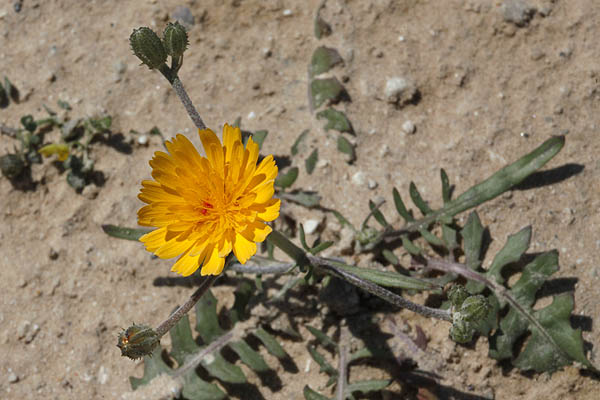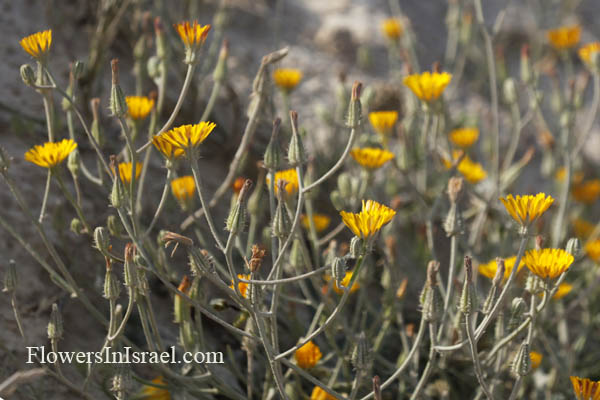سَراغَة شائكَة ,ניסנית שיכנית
| Scientific name: | Crepis aculeata (DC.) Boiss. | |
| Synonym name: | Barkhausia aculeata DC., Crepis pungens Desf. ex Pers | |
| Common name: | (Prickly) Hawksbeard | |
| Hebrew name: | ניסנית שיכנית | |
| Arabic name: | سَراغَة شائكَة | |
| Plant Family: | Compositae / Asteraceae, מורכבים |

|
| Life form: | Annual | |
| Stems: | 15-45 cm high; caudex swollen; flowering stems ascending or erect, tomentose below and at bifurcations, glabrous or sparsely hispid above, branched already from base | |
| Leaves: | Alternate, entire, dentate or serrate | |
| Flowers: | Hermaphrodite, yellow | |
| Fruits / pods: | Dimorphic achenes (two distinct forms); outer achenes fusiform, dorsally curved, laterally compressed, 7.0-9.0 mm long, pubescent, dorsally striate and ventrally smooth, sometimes winged, greyish, yellowish or brown, attenuate, enclosed by the inner involucral bracts, with sparse pappus; inner achenes fusiform, glabrous, finely muricate, orange-brown, with 16-18 ribs, 3-4 ribs somewhat stronger, with a filiform beak, with pappus. Pappus white, united at base, persistent | |
| Flowering Period: | March, April | |
| Habitat: | Sand | |
| Distribution: | Mediterranean Woodlands and Shrublands, Shrub-steppes | |
| Chorotype: | Mediterranean | |
| Summer shedding: | Ephemeral |

Derivation of the botanical name: Crepis, Greek krepis, krepidos "a boot, foundation, pedestal," Latin crepis for an unknown plant (Plinius); Theophrastus used krepis for oxtongue, Helminthia echioides (Theophrastus, Enquiry into plants, book VII. viii. 3). aculeata, with prickles or stings, spine-like; prickly. Barkhausia, named for Johann Conrad Barkhausen (1666-1723), Professor of Chemistry at the University of Utrecht. pungens, spiny, pungent; sharp-pointed.

|